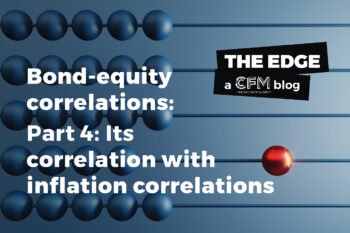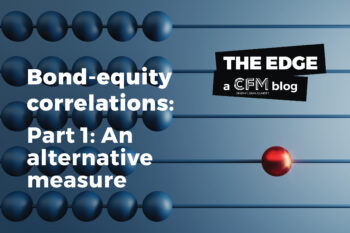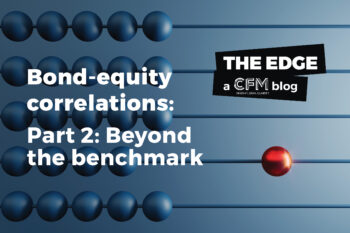Yesterday, May 1, the Fed kept interest rates unchanged as expected. During the FOMC press conference, Chair Powell, citing their dual mandate framework and how shifts in their focus are based on which, either prices or unemployment, is “further away from goal” he remarked that while their focus over the past year was “very much on inflation”, he continued that “inflation has come down to below 3% on a 12-month basis” and that “the other goal [unemployment] now comes back into focus.”
Inflation releases have indeed become hotly anticipated events, and equally a core focus for markets – especially with the recent string of higher-than-expected prints that have raised fears that it may remain ‘stickier’ than predicted. The market’s reaction to the March US inflation print released on April 10 a case in point: the reaction on the day was particularly violent, with the yield on the US 2-year Treasury jumping 27-bps intraday (from a 4.71% low to 4.97% high) – a move that falls above the 98th percentile of intraday moves over the past 20 years.
However, while inflation (and GDP) is a central and closely monitored metric by markets, particularly now, it might come as a surprise to some readers that labor market data releases, and not inflation or GDP, generally trigger more volatile price action for financial securities (specifically bonds).
There are good reasons why this have historically been the case. For starters, the Fed has a dual-mandate, and data on the labor market, as inflation, is closely tracked by policy makers and markets alike. Labor market data is also considered a leading indicator of economic growth, directly affecting consumer confidence and spending (the major component of US economic activity). Labor market strength moreover plays a supporting role in contextualizing inflation data, i.e., whether inflation may be sustained, especially vis-à-vis wage growth. A supplementary explanation is that labor market data is noisy, especially payroll data. Economists’ forecast for non-farm payrolls (NFP) can be, and often are, wide of the mark, leaving room for constant and repeated surprises which magnify market reaction.
Yet, this status quo has been upended post-Covid with inflation releases over the past three years generating higher levels of market volatility. See the panel below.
In these plots we show the yearly distribution of intraday price changes of the US 2-year Treasury future on those days where inflation (CPI, not PCE)1; payrolls and unemployment (NFP); and a leading economic growth indicator (ISM Manufacturing) are respectively released – a proxy to determine the market’s reaction on those days2. The intraday price change is calculated as the normalized percentage change between the low and high prices on each day, with a look-back period of 20 years3. We also calculated and removed the average intraday returns (but excluding the days of these macro releases) in each year. In this way, the distribution shows how much higher the intraday returns for the US 2-year Treasury were in respect to all other days for each of the macro indicators.
Over the entire 20-year period, the mean intraday return on the days of these three releases are all greater than zero (implying the average return on the release dates are on average greater than the average returns on all other days). Intraday returns on unemployment and payrolls release dates, prior to 2022, featured the highest average intraday return (0.77), nearly four times that of CPI (0.22) – with volatility on ISM release days, on average, comparable to those of CPI. Now, when we look at the past three years (colored in red), the average daily reaction in markets have been much more acute on CPI release days (1.87), compared to that for unemployment (1.16).
We also plot the Z-scores of the ‘actual’ releases4 of each indicator over the same period – the markered line in blue. There is a positive, albeit modest correlation between the level of inflation and the volatility that the CPI release triggers in the market, i.e., stronger (weaker) than average reaction when inflation is above (below) its long-term average level. No such correlation exists for labor markets, with generally higher volatility on NFP release days irrespective of underlying unemployment pre-Covid.
This shift is almost certainly, and at least in part due to the swirling concerns over stickier-than-expected inflation. Moreover, inflation post-Covid was driven by a combination of supply chain issues, changes in consumer behavior, and unusual fiscal and monetary policy measures, amongst others – making it much harder to predict the trajectory of prices. Inflation has also been, before COVID and since at least 2010, languishing nearly-consistently at levels below the Fed’s target, making it, during that period, perceivably less critical to monetary policy considerations.
We expect:
- Inflation to remain the main macro driver of volatility in the near-term, but it’s likely to shift once inflation rates stabilize back to the Fed’s target, then traditional drivers of economic health such as job growth and unemployment rates should regain prominence.
- Any shifts could be considered a proxy for what the market thinks the Fed thinks is the most important indicator – all else being equal – in determining changes in monetary policy.
1 PCE tends to trigger less intraday volatility, this on account of the release schedule: for the same monthly period, PCE is typically released after CPI, with markets incorporating their expectations for PCE based on the CPI release.
2 These macro indicators are broadly regarded as amongst the most relevant and broadly tracked economic prints each month.
3 The returns are normalized with the standard deviation over the entire period, i.e., non-causally.
4 The ‘actual’ release values are the data released on the day, and not the post-release revised values. Most-all macroeconomic data are subject to review, with the revisions – depending on the data – not trivially different than the actual release.
Disclaimer
ANY DESCRIPTION OR INFORMATION INVOLVING MODELS, INVESTMENT PROCESSES OR ALLOCATIONS IS PROVIDED FOR ILLUSTRATIVE PURPOSES ONLY AND DOES NOT CONSTITUTE INVESTMENT ADVICE NOR AN OFFER OR SOLLICITATION TO SUBSCRIBE FOR ANY SECURITY OR INTEREST. ANY STATEMENTS REGARDING CORRELATIONS OR MODES OR OTHER SIMILAR BEHAVIORS CONSTITUTE ONLY SUBJECTIVE VIEWS, ARE BASED UPON REASONABLE EXPECTATIONS OR BELIEFS, AND SHOULD NOT BE RELIED ON. ALL STATEMENTS HEREIN ARE SUBJECT TO CHANGE DUE TO A VARIETY OF FACTORS INCLUDING FLUCTUATING MARKET CONDITIONS AND INVOLVE INHERENT RISKS AND UNCERTAINTIES BOTH GENERIC AND SPECIFIC, MANY OF WHICH CANNOT BE PREDICTED OR QUANTIFIED AND ARE BEYOND CFM’S CONTROL. FUTURE EVIDENCE AND ACTUAL RESULTS OR PERFORMANCE COULD DIFFER MATERIALLY FROM THE INFORMATION SET FORTH IN, CONTEMPLATED BY OR UNDERLYING THE STATEMENTS HEREIN. CFM ACCEPTS NO LIABILITY FOR ANY INACCURATE, INCOMPLETE OR OMITTED INFORMATION OF ANY KIND OR ANY LOSSES CAUSED BY USING THIS INFORMATION. CFM DOES NOT GIVE ANY REPRESENTATION OR WARRANTY AS TO THE RELIABILITY OR ACCURACY OF THE INFORMATION CONTAINED IN THIS DOCUMENT.




